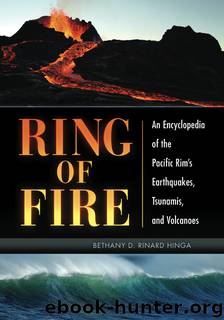Ring of Fire by Hinga Bethany;

Author:Hinga, Bethany;
Language: eng
Format: epub
ISBN: 1956523
Publisher: ABC-CLIO, LLC
Mexico City Earthquake, Mexico (1985)
On September 19, 1985, Mexico was hit with a magnitude 8 earthquake. Its epicenter was in a subduction zone in the western part of the country, near Michoacán. At least 9,500 people were killed, about 30,000 were injured, and more than 100,000 people were left homeless. Severe damage occurred in parts of Mexico City and in several states of central Mexico. It is estimated that the quake seriously affected an area of approximately 300,000 square miles, caused more than $3 billion in damage, and was felt by almost 20 million people.
This was one of the most devastating earthquakes in the history of the Americas, and it was followed by major aftershocks. In Mexico City, shaking from the quake lasted three to four minutes. The most damaged zones were those in the bed of historic Lake Texcoco, where the prevailing silt and volcanic clay sediments amplified the shaking. Building damage was worsened by occurrences of soil liquefaction, causing loss of foundation support and settlement of large buildings. Altogether 400 buildings collapsed and another 3,000 were seriously damaged. Extensive damage also occurred all across the country.
The earthquake generated a small tsunami, and the first aftershock that was a magnitude of 7.5 produced a small second tsunami. Both tsunamis spread across the Pacific and were recorded by several tide stations in Central America, Colombia, Ecuador, French Polynesia, Samoa, and Hawaii. No reports of damage were received from any of these stations and the only minor damage due to the first tsunami came from the source region. Seiches were observed in East Galveston Bay, Texas, and in swimming pools in Texas, New Mexico, Colorado, and Idaho. Water-well fluctuations were recorded at Ingleside, Texas; Santa Fe, New Mexico; Rolla, Missouri; Hillsborough County, Florida; and Smithsburg, Maryland.
As compared with California, which in the course of the Twentieth Century experienced five earthquakes of magnitudes greater than 7, Mexico had 42—most of them resulting in a high death toll. The September 1985 quake happened in a seismicity gap that had been identified by geologists as a risk area for the previous 10 years. Fortunately, the earthquake struck early in the morning of September 19, before schools and offices in Mexico City were occupied, because it was there that the greatest death toll occurred when buildings collapsed. The length of the intervening distance between the earthquake’s source and Mexico City greatly reduced the amplitude of the seismic waves so that very few structures built on firm soil and rock suffered damage.
See Also: Mexico.
Download
This site does not store any files on its server. We only index and link to content provided by other sites. Please contact the content providers to delete copyright contents if any and email us, we'll remove relevant links or contents immediately.
Man-made Catastrophes and Risk Information Concealment by Dmitry Chernov & Didier Sornette(4735)
The Revenge of Geography: What the Map Tells Us About Coming Conflicts and the Battle Against Fate by Kaplan Robert D(3597)
Zero Waste Home by Bea Johnson(3290)
COSMOS by Carl Sagan(2950)
In a Sunburned Country by Bill Bryson(2946)
Good by S. Walden(2915)
The Fate of Rome: Climate, Disease, and the End of an Empire (The Princeton History of the Ancient World) by Kyle Harper(2436)
Camino Island by John Grisham(2383)
A Wilder Time by William E. Glassley(2363)
Organic Mushroom Farming and Mycoremediation by Tradd Cotter(2307)
Human Dynamics Research in Smart and Connected Communities by Shih-Lung Shaw & Daniel Sui(2178)
The Ogre by Doug Scott(2114)
Energy Myths and Realities by Vaclav Smil(2060)
The Traveler's Gift by Andy Andrews(2011)
Inside the Middle East by Avi Melamed(1939)
Birds of New Guinea by Pratt Thane K.; Beehler Bruce M.; Anderton John C(1906)
Ultimate Navigation Manual by Lyle Brotherton(1767)
A History of Warfare by John Keegan(1714)
And the Band Played On by Randy Shilts(1615)
